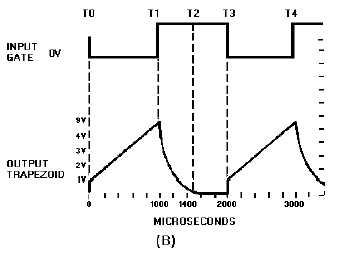3-48
Figure 3-50B.—Trapezoidal waveform generator.
With Q1 conducting very hard, collector voltage is near 0 volts prior to the gate being applied. The
voltage across R2 is about 50 volts. This means no current flows across R3, and C2 has no charge.
At T0, the negative alternation of the input gate is applied to the base of Q1, driving it into cutoff. At
this time the transistor is effectively removed from the circuit. The circuit is now a series-RC network
with 50 volts applied. At the instant Q1 cuts off, 50 volts will appear across the combination of R2 and
R3 (the capacitor being a short at the first instant). The 50 volts will divide proportionally, according to
the size of the two resistors. R2 then will have 49.5 volts and R3 will have 0.5 volt. The 0.5 volt across
R3 (jump resistor) is the amplitude of the jump voltage. Since the output is taken across R3 and C2 in
series, the output "jumps" to 0.5 volt.
Observe how a trapezoidal generator differs from a sawtooth generator. If the output were taken
across the capacitor alone, the output voltage would be 0 at the first instant. But splitting the R of the RC
network so that the output is taken across the capacitor and part of the total resistance produces the jump
voltage.
Refer again to figure 3-50, view (A) and view (B). From T0 to T1, C2 begins charging toward 50
volts through R2 and R3. The time constant for this circuit is 10 milliseconds. If the input gate is 1,000
microseconds, the capacitor can charge for only 10 percent of 1TC, and the sawtooth part of the
trapezoidal wave will be linear.
At T1, the input gate ends and Q1 begins to conduct heavily. C2 discharges through R3 and Q1. The
time required to discharge C2 is primarily determined by the values of R3 and C2. The minimum
discharge time (in this circuit) is 500 microseconds (5K
W
.02µF
5). At T2, the capacitor has
discharged back to 0 volts and the circuit is quiescent. It remains in this condition until T3 when another
gate is applied to the transistor.
The amplitude of the jump voltage was calculated to be 0.5 volt. The sawtooth portion of the wave is
linear because the time, T0 to T1, is only 10 percent of the total charge time. The amplitude of the
trapezoidal wave is approximately 5 volts. The electrical length is the same as the input gate length, or
1,000 microseconds. Linearity is affected in the same manner as in the sawtooth generator. Increasing R2
or C2, or decreasing gate width, will improve linearity. Changing the applied voltage will increase output
amplitude, but will not affect linearity.

